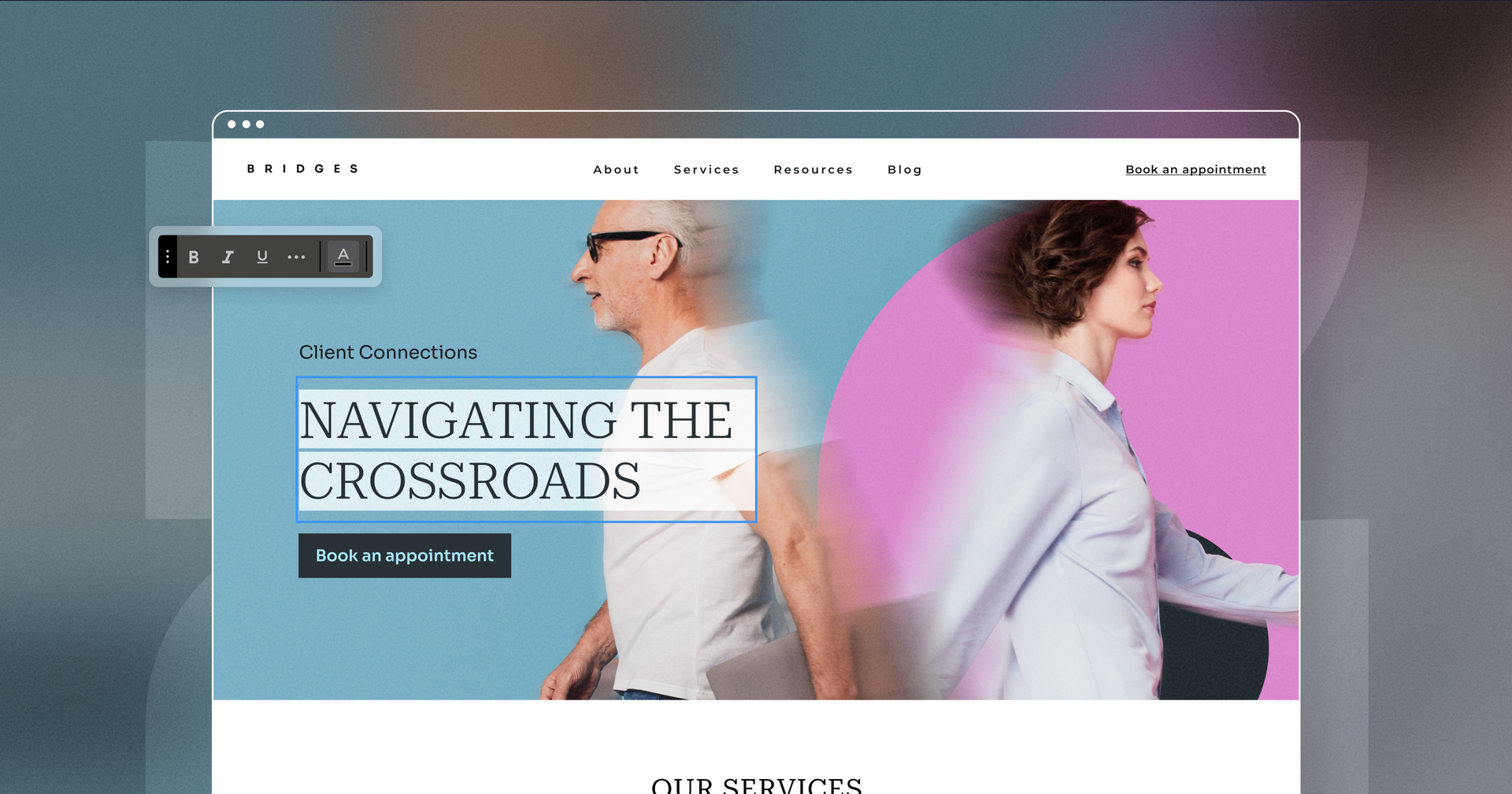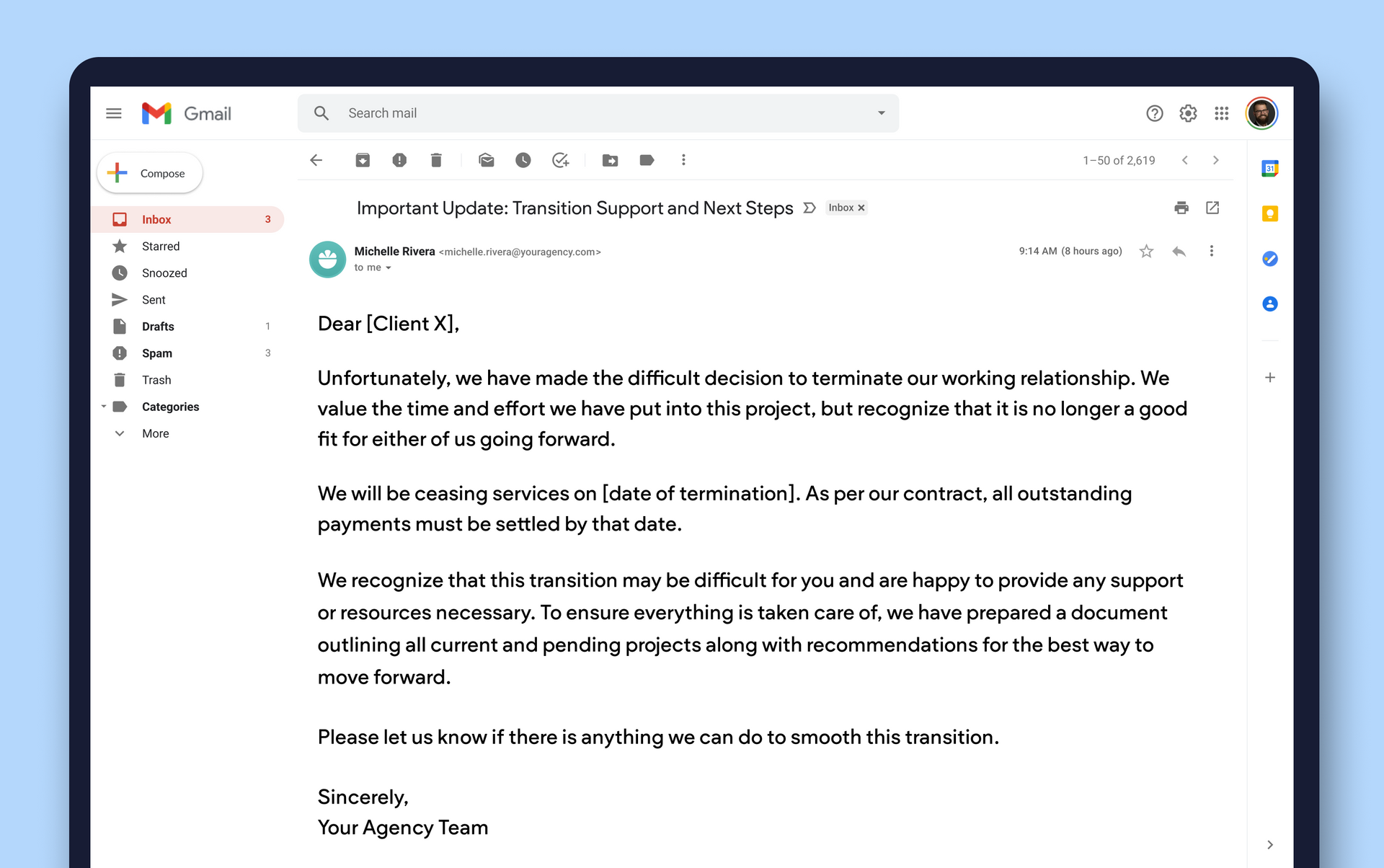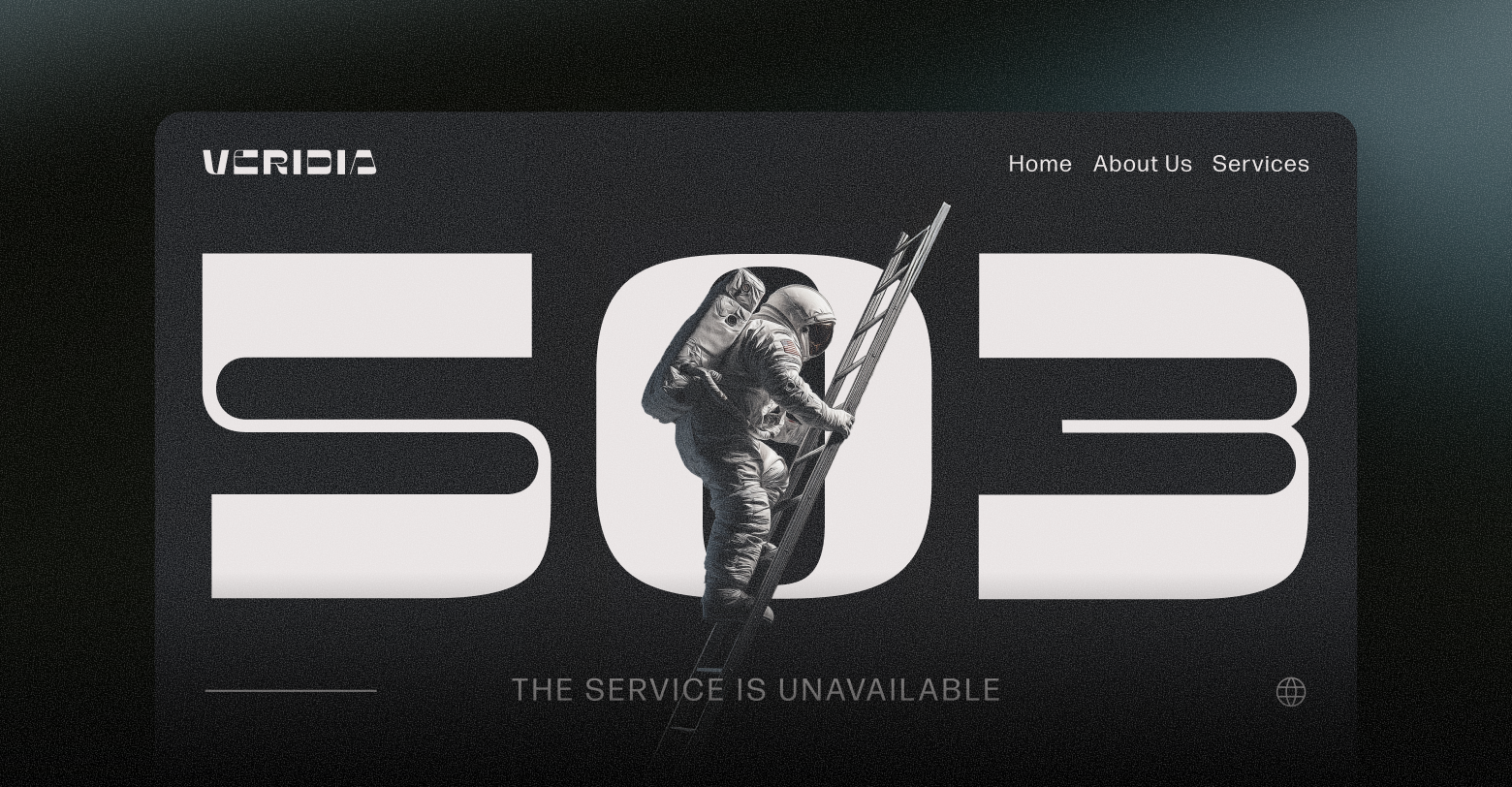We've all been there — unfortunately, it's one of the realities of running an
agency.
Strong client relationships help you retain your current clients, find new ones through referrals and public reviews, and make running your business more efficient.
You and your employees both need healthy client relationships, but that isn't always how the cookie crumbles.
There are tons of reasons you might want to sever ties professionally. Maybe you've outgrown their needs and your relationship just isn't as productive or valuable. Or they treat you poorly, miss payments, or ask for one too many revisions all too often.
If you're growing your business and haven't honed in on your ideal customer yet, you might need to stop working with them even if they aren't particularly difficult to deal with.
In any case, bad clients cost you money and stress out your employees and freelancers. And part of being a business owner is making decisions that push your company forward.
Before you hit send on that “it’s not going to work out” email, you need to make sure you do it right. In this article, we'll tell you everything you need to know about firing a client professionally.
Setting Boundaries With Clients
Boundaries are the guardrails protecting you and your team. They set clear expectations, foster healthy relationships, and keep your employees from burning out.
When it comes to client relationships, they also prevent misunderstandings and scope creep.
For instance:
If your contract states that you won't do any work outside the original project scope, then make sure to communicate that early on. If your client agrees, then it should be fairly easy to push back when they ask for extra tasks.
In this sense, you are partially responsible for how your business relationships turn out, and you can't always blame clients for issues that come up.
Had you set boundaries from the beginning, you could have prevented future difficult conversations.
Let's take a look at some critical boundaries that can save your relationships before they sour.
Payment Parameters
Getting paid on-time is quite literally a matter of survival.
New QuickBooks research shows that two of every three businesses spend 14 hours per week collecting payments and completing the related administrative tasks. That's nearly two full days that could have been spent completing projects, selling, or strategizing.
Mid-sized businesses face an average of $304,066 in late payments from their customers. 81% of them reported that their customers have been making late payments more often compared to previous years.
For small business owners (about one-fourth of whom don't even pay themselves a salary), the cash flow implications are much more significant.
Here are a few common examples of payment parameters you can set up contractually with your clients:
- Require an initial deposit or full payment upfront
- Send invoices as soon as a project is completed and regularly follow-up on unpaid bills (software can automate this)
- Include a late fee policy in the contract so customers are aware of it from day one
- Immediately stop working on a project until all the payments are settled
- Consider accepting payment by credit card, which includes chargeback protection
Revision Requests and Work Orders
Entrepreneurs tend to learn this problem early on (the hard way): Clients often want more than they originally anticipated.
If you don't state in the contract what type of revisions requests will cost extra (if any), your team can end up doing almost double the work while only you only get paid for one job.
To avoid scope creep and protect yourself, the most important first step in initiating a client relationship is setting limits on revision requests when outlining your scope of work.
This will vary depending on the type of agency you run and the work you do. Most agencies offer a maximum of three rounds of revisions as part of the scope of work.
But feel free to limit that amount or make it dependent on incremental payments (e.g. one extra round for a 25% fee).
Response Times and Communication
If you've ever had a toxic client send you emails and Slack messages at 7PM on a Friday, then get frustrated when you don't respond until Monday morning, then you know how important response times are.
Juggling multiple projects means that no particular client should feel entitled to an immediate response from your team members.
Having clear expectations on communication and response times will save your sanity in the long run.
For instance: You can set up an agreement that emails, questions, comments, and revisions should be answered within one business day or less. Or, if a client expects immediate responses, you can determine what warrants a quick response and what doesn’t.
Be sure to specify which channels of communication are preferred (e.g., email vs. phone call) so both parties know where it's best to reach out with questions and requests.
It helps to use a project management software (Duda has client management built-in for this exact reason) that stores all client conversations in one place.
This way, everyone is on the same page regarding communication expectations and you can ensure nothing falls through the cracks.
Signs of a Client Relationship Gone Sour
Whether your clients play the blame game despite clear boundaries or they are constantly asking for more without additional compensation, pay attention to red flags that come up throughout your business relationship.
These include:
- Unpaid invoices, late payments, or haggling.
When customers continuously fail to pay on-time, it may be a sign that they don't value the services you and your team are providing.
- Unrealistic expectations.
If clients continually ask for more than what was outlined in the scope of work, constantly change their minds, or constantly make last-minute requests, the relationship may never be mutually beneficial.
- Opportunities that never happen. If a client continuously promises huge project spend and partnership opportunities in front of you that never come to fruition, you’ll eventually have to discern between a “dream client” and reality.
- Miscommunication (or lack thereof). Good clients won't leave you hanging while you're trying to drive a project to completion. For you to do the best work possible, you need clients who communicate with your team to troubleshoot issues and make improvements on schedule.
- Not respecting your boundaries. If clients are constantly trying to get around the terms of the contract (e.g., not paying for additional services) or expecting more than was initially agreed upon, it's a clear sign that something is seriously wrong.
- Rudeness or lack of professionalism toward your employees and freelancers. Respect and mutual understanding should be a baseline expectation of any working relationship. If clients are speaking to your team with anything less than respect, it's time to part ways.
- Indecisiveness.
Some clients just don’t know what they want. They sit on calls, talk with your team, and spend a week deliberating internally, just to come back with an “I don’t know” response. If someone you’re working with can’t pick a package, decide on services, or even choose between Option A and Option B, they’re a problem client.
The most challenging clients will probably meet more than one of these criteria. Perhaps the most well-known of all is the client who never pays enough or on-time, but demands the world.
Other Reasons to Let Go of a Difficult Client
Problematic clients are more than just a hassle to deal with — they also cost you money and wear out your team members.
Even if everything seems to be running smoothly, pay attention to these other red flags:
- Refusal to listen to your advice.
Nightmare clients who don't listen to your advice, then aren't satisfied with the results can ruin your reputation. If they have a large following, their negative feedback may spread to others and tarnish future partnerships with you.
- Changing needs or out-of-scope requests. It might not be your fault if a client needs something that can't easily be completed without further training or resources that you don't have readily available. But if they keep pressuring you to do it, that's a sign they
aren't happy with the work you're doing.
- Employees showing signs of burnout.
Stressed out employees show lower engagement levels, are less productive, and take more sick leave compared to those who aren't. Removing the cause of stress can boost morale and productivity, leading to positive outcomes for your business.
- Changing definition of the ideal client.
Scaling marketing agencies have changing needs. Moving away from a great client is the right decision if their deliverables, customer profile, or budget are no longer profitable or fit into your system. Even if it’s tough, this business decision will free you up to take on new clients that fit your outlook and business goals.
6 Steps to End a Working Relationship With a Client
If it's time to sever ties with a client, follow these seven steps to do so the right way.
1. Weigh the pros and cons, and evaluate for salvageability
Firing a client should be a last resort. Acquisition is 6 to 7 times more expensive than retention, and there may be negative results you can't control.
Before carrying through with your decision, ask yourself the following questions:
- Do I need this client? "Need" is a strong word, but a client comprising 25% of your income might be worth salvaging, even if the situation isn't ideal.
- Have I held up my end of the bargain? Check your contract and scope of work to make sure everything has been fulfilled. If it has, ensure the client is aware of this before jumping to conclusions. If it hasn't, complete everything before terminating your working relationship.
- Is it just because of the money? If you're only getting rid of a client because they aren't profitable, talking through it with them could actually save the situation. Many clients are open to raising rates, especially if the work you've done for them has been satisfactory thus far.
- Have my team and I been consistent?
To maintain a strong relationship with your client, it's important to communicate with them regularly. If they are not responding or providing the necessary documents or information, it can make it difficult to complete their requested work. If the blame falls partially on you or your team, consider being more responsive before taking any further action.
- Is the relationship beyond fixable? Upon further thought, you'll probably find that most of your relationships aren't completely in the gutter. Look for signs like whether the client has suggested ideas to improve the situation, and try to work with the client on the problems you're having before you follow through with a contract termination.
- How do my employees feel?
If you aren't working directly on projects, you might not see everything behind the scenes. If you're serious about terminating a client, talk with your employees who work hands-on with them to see what they feel.
2. Create your exit strategy
If you're ready to move forward, you need to come prepared. That starts with an exit strategy.
Every exit strategy should include:
- A timeline for completion of current services and when you will stop providing services
- An outline of all the work you have completed, what still needs to be done, and who is responsible for it
- Any adjustments to the client's current payments or refunds they are entitled to
- Documentation on any ongoing projects that need transferring or completion
- Payment requirements
- A recommendation or referral for future agency work that aligns with their needs
- Assistance you plan to offer during the transitionary period
Check your contract or engagement letter before finalizing your termination notice and supplementary documentation — you might run into problems if your client refers to terms that prevent you from doing so (such as a guarantee of services for a set period).
3. Prepare your communication
Once you have your exit strategy and supporting documents ready, reach out to the client with a professional notification detailing how you will be ending the relationship and why.
When communicating with the client, always remember to:
- Maintain your integrity.
Be rational, polite, and respectful. Don't use this as an opportunity to vent your frustrations or assign blame.
- Keep it brief and concise. The longer you talk, the more chances for misunderstandings and hurt feelings.
- Be specific about the reason for termination.
Even if you think your client knows why, it's best to be clear and direct.
- Have a solution-oriented mindset. If there is any way you can help them through this transition, such as providing them with a list of other agencies they could work with, do it.
- Take responsibility where necessary
Here is a sample script of a well-written client termination notice:
4. Set up a meeting with the client and remain professional (if applicable)
If the client is open to it, a face-to-face meeting can be beneficial. It's an opportunity for both sides to discuss the situation and come up with solutions that benefit everyone involved.
When you meet with the client:
- Be honest about why you're making this decision.
This isn't the time to sugarcoat things; your client deserves to know the truth.
- Find solutions and make sure everyone's needs are taken care of.
Your goal is not to win an argument, but rather to ensure both parties leave with a positive outcome.
- Be open to feedback from the client and address any issues they may have with the decision.
Especially if a particular client has been problematic in the past, face-to-face problem solving could save your company from a nasty review or social media post.
- Make sure to thank your client for the opportunity to work together and respect their decision — even if they don't agree with it.
A client meeting isn't always required, but it could be a good idea if you think it could help both parties understand the situation better.
5. Follow up in writing to document the termination
Keeping a paper trail of everything discussed is important, especially if a termination agreement goes south. It can protect your reputation and allow you to defend yourself in the event of legal trouble.
A follow-up email should include:
- A brief summary of the conversation
- Any agreements or commitments made by either party during the meeting
- An explanation of how to dispute any invoices or payments if necessary
- Information about recommendations for other agencies, if applicable
- A thank you and a polite request to not post negative reviews about your agency
- A form to submit private feedback
Your follow-up should be sent within 24 hours of the termination meeting, and you should make sure to keep a copy for your records.
6. Use the opportunity as an exercise in self-reflection
Sometimes it's not just the client who is to blame when a project goes south. While you shouldn't take on all of the burden yourself, reflecting on what went wrong can help you fix other client relationships or prevent future problems from happening.
Take some time to think about what could have gone better — was communication an issue? Did the scope of work need to be revised? Did you overestimate your capabilities?
These reflections can make you a better agency owner in the future. Use them to adjust processes or create new policies that will help you work more efficiently and effectively.
Final Thoughts
Healthy client relationships are vital, but so is the health of you, your employees, and your company. If a client begins to infringe on your success, then it's time to let them go.
Although firing a client should be a last resort, strong relationships go both ways. If you've exhausted your other options and weighed the pros and cons, letting a problem client go might be the best decision for the success of your business and its employees.
Taking the right steps when doing so will save you from bad reviews, legal issues, and potentially ruining your reputation with other clients.
By following the tips outlined here, you can fire a client in the best way possible for everyone involved — preserving your reputation as an agency owner and allowing both sides to move on with their own goals in mind.
Related Posts
By Ilana Brudo
•
November 13, 2025
Don't let AI-generated websites cause day-two headaches. Learn why agencies need governance and control, and how Duda's AI stack offers speed without the risks.
By Shawn Davis
•
November 6, 2025
Learn how Jared Broussard's agency scaled client websites by switching from WordPress to Duda, saving time and costs while boosting efficiency and growth.
By Ilana Brudo
•
October 30, 2025
Stop the magic, start the security. Uncover the hidden risks of AI "vibe coding" in web development and build safer websites for your clients.
Show More










